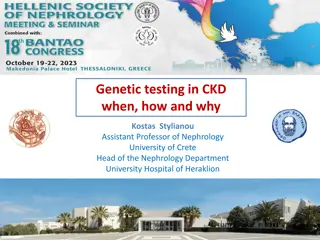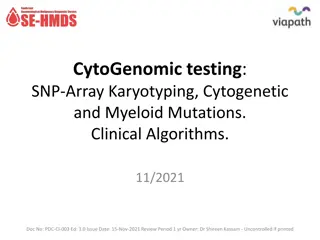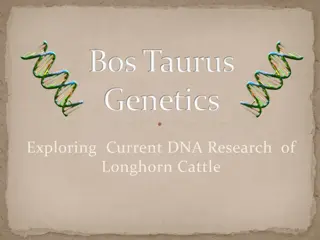Genetic Purity Testing Methods in Agriculture
Genetic purity testing is crucial in agriculture to ensure the trueness of plant varieties and prevent contamination. Various tests such as the phenol color test for wheat, rice, and sorghum, KOH bleach test for sorghum, and peroxidase activity test for soybean are used to assess genetic purity accurately. By understanding and employing these testing methods, farmers can maintain high-quality crops and improve overall agricultural productivity.
Download Presentation

Please find below an Image/Link to download the presentation.
The content on the website is provided AS IS for your information and personal use only. It may not be sold, licensed, or shared on other websites without obtaining consent from the author.If you encounter any issues during the download, it is possible that the publisher has removed the file from their server.
You are allowed to download the files provided on this website for personal or commercial use, subject to the condition that they are used lawfully. All files are the property of their respective owners.
The content on the website is provided AS IS for your information and personal use only. It may not be sold, licensed, or shared on other websites without obtaining consent from the author.
E N D
Presentation Transcript
CONTENTS Introduction Need for genetic purity testing Various tests for genetic purity-Phenol test for Wheat and Rice KOH bleach test for Sorghum Sodium hydroxide test for Wheat Peroxidase activity test for Soyabean Modified Phenol test for Wheat
INTRODUCTION So basically genetic purity refers to the trueness to the type or degree of contamination caused by the undesired genetic varieties. Deterioration could be caused to genetic purity due to various factors which are Mechanical mixture, Mutations , Developmental variations, Natural crossing etc.
NEED FOR GENETIC PURITY TESTING To increase crop production at national level. To increase farmers income and standards of living. For DUS test Quality control for grain processing
PHENOL COLOUR TEST Varieties of cereals particularly wheat ,rice and sorghum are verified Through involvement of the enzyme tyrosinase using phenol as a substance (walls,1965) Seed treated with fungicide are rinsed with methanol prior to soaking. Seeds are placed in a beaker and immersed in distilled water. Two sheets of filter paper are arranged in petriplate,seeds are arranged on filter paper. 1% solution of carbolic acid applied in each petriplate with help of pipette till th part of seed is covered.
After carbolic acid application ,petriplate covered with lid to avoid evaporation. The petriplate us placed in incubator for a required period at specific temperature. Seeds are observed for development of colour and it s intensity to distinguish the genetic impure seed. Intensity of the colour developed on the seed is observed as no reaction (-)deep olive(+), lights brown (++), brown (+++)and black (++++). Seed pure at genetic level express similar intensity of colour in response to the test.Similarly expression indicates genetic impurity. any seed showing variation in
KOH BLEACH TEST This test is mainly performed for estimating genetic purity for sorghum crop. The presence or absence of a darkly pigmented testa can be used to differentiate sorghum cultivars. The dark pigment is tannic acid. Steps-Prepare 1:5(w/v) solution of KOH and fresh bleach (5.25%NaOCl) Put seeds in glass container and completely cover with KOH bleach solution. Soak the seeds with brown seed coats for 10min and seeds with white coat for 5 min. Gently rinse with tap water then air dried it. Record number of dark and light seeds and they are examined for presence of dark pigmented tannic acid.
Sodium hydroxide test for wheat A chemical test used to distinguish between red and white wheat in situations where it is difficult to distinguish between the two types (i.e. when seeds have been weather-damaged, treated, or are simply hard to distinguish by the naked eye). Procedure- 100 seeds were soaked in three replications in 5%NaOH solution for one hour at room temperature. Changes in the colour of seeds are observed after one hour . Based on the colour intensity of seed Genotypes were classified into three groups which is dark brown, light brown and brown
Peroxidase test for Soyabean This test is approved for DUS testing of soyabean. Presence or absence of peroxidase enzyme in seeds of crop from family leguminaceae is under genetic control therefore, variety may be verified bases on variation in the expression with the reaction of Hydrogen peroxide (Buttery and Buzzell,1968) Procedure-Remove seed coats and place in separate test tubes Add 0.5-1.0 ml of 0.5% guaicol & wait for 10 minutes Then add 0.1 ml of 0.1% Hydrogen peroxide solution to each tube. If the solution turns dark reddish brown - +ve reaction If solution remain clear- --ve reaction
Modified Phenol test Modified phenol test was followed as described by Banerjee and Chandra (1977). Procedure- 50 seeds were taken and soaked in 0.4 % solution of Copper sulphate for adding Cupric ions and another set in 0.6 % Sodium carbonate for adding sodium ions for 4 hrs. Then the seeds were placed in 2%phenol solution after removing from both the solutions overnight. Based on the colour development in both the Tests groups were made and classified in to three groups dark brown, brown and reddish brown colour in Copper sulphate soaked seed while it is classified into three groups brown, dark brown and strong brown for Sodium carbonate soaked seeds.
Biochemical test Fluorescent test Phenol colour test Sodium hydroxide test KOH bleach test KOH test Peroxidase activity test Copper sulphate ammonia test Seedling colour Reaction of seedling root to UV light Ammonium fluorescent test Amylose content in endosperm Gelatinization temperature Aroma in decorticated seed Erucic acid content in the seeds Glucosinolate in seed Oil content HCl test Lugols test for lupine Crop Oat Wheat, rice and Sorghum Wheat Sorghum Wild rice Soyabean Melilotus alba Cereals, soyabean and pigeonpea Rye Festuca rubra and f. ovine Rice Rice Rice Rapeseed Rapeseed and mustard Rapeseed, mustard and sesame Faba bean and phaseolus vulgaris Lupine























